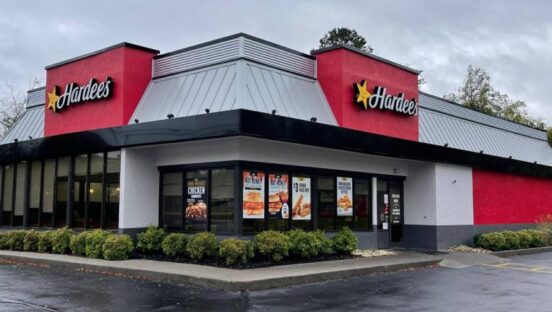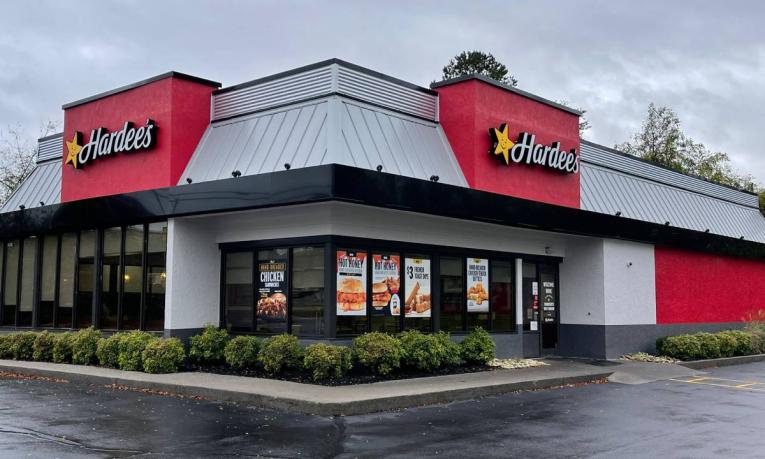Few industry topics, if any, have collected as many thoughts in the past year as artificial intelligence. You can find some here in our insights series from the National Restaurant Association Show. There’s zero question it’s flooded today’s operational conscious. But whether it’s a hidden technology or one at the forefront of the guest experience is something that continues to tilt. CKE Restaurants, the parent company of Hardee’s and Carl’s Jr., is among those quick-service brands diving in on the drive-thru side with voice-automated ordering. Automation technology provider Presto in September announced a deal with CKE Franchise Group StarCorp for all 58 of its Carl’s Jr. locations. It piloted the tech at two stores for six months, achieving a 91 percent upsell offer rate before deciding to roll it out. Before, CKE teamed with Presto, Valyant AI, and OpenCity AI to spread the technology through the company’s system.
Clearly, it’s a fit for CKE’s base and what it’s hoping to achieve. Yet there are layers and nuances to the decision, both for CKE and peers, company chief technology officer Phil Crawford shares. Is it the right path for every brand in quick service? And what are the true unlocks, aims, and potential ahead?
As part of this year’s QSR Drive-Thru Report, we caught up with Crawford to discuss CKE’s decision and the broader topic at length.
Let’s start with CKE’s recent AI expansion at the drive-thru. How is this evolving? What are the benefits thus far/areas of improvement still to come?
We continue to roll-out AI drive-thru technology throughout the system. Like any new technology, we are partnering with our providers to refine the systems to ensure the best possible experience for our guests and team members. For instance, we continue to make advances in our upsell and meal add-on scripts to complement the ordering experience, not deter from it. So far, we are excited about the results we are seeing, which are measurable changes in service execution, product quality, increased revenue, and a decrease in costs in drive-thru operations.
Generally, what are your thoughts on AI tech for drive-thru in quick service overall? Is this an inevitability? Or will it work better for some brands than others?
AI Technology has a vast potential in all aspects of the hospitality industry, and quick service is no exception. AI-powered drive-thru systems can enhance operational efficiency, personalize customer experiences, and streamline order processes. Here are a few thoughts:
Operational Efficiency: AI can automate order-taking, and potentially speed up service times. It could also be integrated with inventory management systems to suggest menu items based on real-time supply levels.
Personalization: Leveraging machine learning algorithms, AI could offer personalized menu recommendations based on previous customer behavior, dietary preferences, or current promotions. This could boost sales while making customers feel individually catered to.
Voice Recognition and Understanding: Modern AI is getting increasingly good at understanding and interpreting human speech, even with ambient noise or various accents. This makes it viable for use in drive-thru scenarios.
Data Analysis: AI could capture and analyze data from each transaction, enabling quick-serves to better understand their customers and make more informed business decisions.
However, despite these benefits, the implementation and effectiveness of AI in the drive-thru experience could indeed vary among brands. This variation could be due to the following factors:
Brand Image: Some quick-service restaurant brands may have a brand image centered on personal, human interaction, which might be diminished with the implementation of AI technology. For these brands, it will be crucial to find a balance between tech-driven efficiency and maintaining their personal touch.
Customer Demographics: Depending on the demographic, some customers may prefer human interaction over an AI interface, while younger, tech-savvier demographics might appreciate the convenience and novelty of AI interaction.
Cost and ROI: The cost of implementing advanced AI systems can be high, and not every quick-serve might have the necessary resources or see a satisfactory return on investment, especially in the short term. Smaller or less profitable QSRs might find it more challenging to implement such technologies than large, well-established chains.
Technical Adaptation: The success of AI implementation would require seamless integration with existing systems like POS, inventory management, and others. Some brands might have more adaptable systems than others.
In conclusion, the use of AI technology in the quick-service drive-thru is not necessarily an inevitability for all restaurants but is a promising avenue for many. Brands that can successfully navigate the potential challenges will likely find themselves at a competitive advantage. The key will be in thoughtful implementation that enhances customer experience and operational efficiency without sacrificing the brand’s unique qualities.
How have the success metrics of drive-thru changed from 2019 to today? Is speed of service still king, or has the consumer changed preference in line with other habits? For instance, do they expect accuracy now similar to mobile ordering in other parts of their lives?
Since 2019, the drive-thru experience has undergone significant changes due to evolving customer habits and expectations, as well as the global shift prompted by the COVID-19 pandemic. Speed of service remains crucial, but other factors have gained prominence as customers prioritize safety, accuracy, and digital convenience in their experiences. Here are some key changes in drive-thru success metrics:
Speed of Service: While speed remains important, it may not be the ultimate king anymore. With the introduction of new ordering technologies and menu items, speed might be compromised in favor of other aspects such as order accuracy or menu complexity. Still, reducing wait times continues to be a major focus for quick-service restaurants.
Order Accuracy: Given the rise of mobile and online ordering systems, customers have grown accustomed to a high level of accuracy, and they expect the same from drive-thrus. Incorrect orders can lead to customer dissatisfaction and harm brand reputation, so this has become a critical performance metric for drive-thrus.
Digital Integration: The ability to integrate with digital ordering platforms, apps, and contactless payment methods is now a significant factor. Customers appreciate the convenience and safety of these systems. Brands that seamlessly connect their drive-thrus with digital technology generally have an edge.
Health and Safety: Measures to ensure health and safety have become vital success metrics since the COVID-19 pandemic. This includes contactless transactions, sanitization practices, and even the personal protective equipment used by staff. These factors can influence a customer’s decision to choose one drive-thru over another.
Sustainability: With increasing awareness about environmental issues, some consumers consider the sustainability efforts of a brand before choosing where to dine. This includes factors like waste reduction initiatives, use of recyclable materials, and the carbon footprint of the business.
Customer Experience: Alongside speed and accuracy, overall customer experience has become a more holistic metric. This can include the friendliness of service, the ease of ordering, and even the physical design of the drive-thru.
These changes suggest a more nuanced approach to evaluating drive-thru success. It’s not solely about speed anymore. Quick-service restaurants now need to deliver an accurate, convenient, safe, and enjoyable customer experience while keeping pace with digital trends and sustainability concerns.
Where do you think the future of drive-thru is headed?
As technology advances and customer expectations evolve, the future of drive-thru in the quick-service restaurant industry is set to undergo several transformative changes. Here are some predictions:
Artificial Intelligence: We’re likely to see increased use of AI in order management, from voice recognition to order processing. AI could customize menu suggestions based on a customer’s past orders, dietary preferences, or even the current weather. In addition, AI-driven analytics could help restaurants improve their services based on real-time data.
Advanced Digital Integration: Customers might be able to place an order and make a payment through an app before reaching the drive-thru, making the process even more seamless and quick. Integration with other digital platforms could also provide opportunities for unique marketing and loyalty programs.
Personalization: Enhanced data collection and analysis can help restaurants offer more personalized service, tailoring suggestions to individual customer preferences and purchasing habits.
Contactless Transactions: In the wake of the COVID-19 pandemic, contactless service became a significant trend. This could include contactless payment methods and even delivery systems, such as conveyors, to minimize contact.
Sustainability: As public consciousness about environmental issues grows, drive-thru operations may aim to reduce their environmental impact. This could include energy-efficient designs, reducing waste, and utilizing recyclable or biodegradable packaging.
Multi-Lane and Multi-Window Drive-Thrus: To accommodate increasing demand and enhance speed of service, more restaurants might adopt multi-lane or multi-window designs. There could also be specific lanes for different purposes—like mobile pickups, delivery driver pickups, or traditional drive-thru service.
Enhanced Drive-Thru Designs: The physical design of drive-thrus could also change. For example, we might see the use of digital menu boards with high-quality graphics, drive-thrus designed to improve traffic flow and reduce congestion, and more aesthetically pleasing designs to enhance customer experience.
Virtual and Augmented Reality: Although more speculative, future drive-thrus might incorporate VR or AR to provide unique and interactive customer experiences, such as virtual menu browsing or promotional games.
The drive-thru of the future will likely be more technologically advanced, highly personalized, and eco-friendly, catering to a consumer base that values speed, convenience, safety, and sustainability. However, despite these advances, the essential goal will remain the same: to provide customers with a fast, convenient, and satisfying dining experience.








